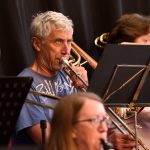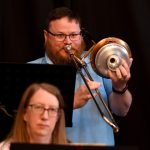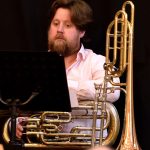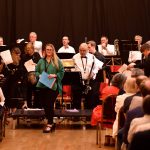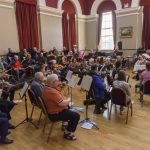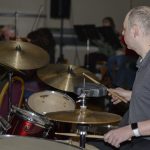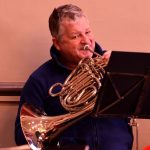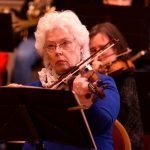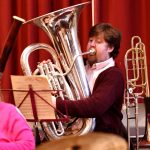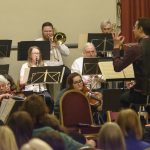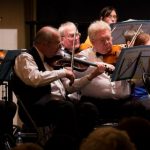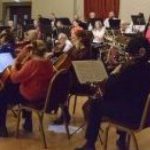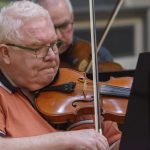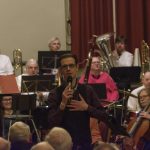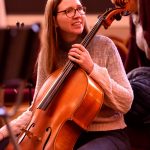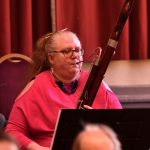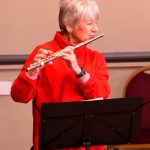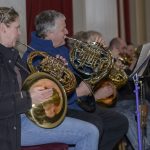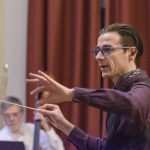NEXT CONCERT – will be 25th January 2025 .
Programme for Summer Concert, Saturday 1 July
Program notes by Helen Devonshire
‘Pique Dame (Queen of Spades): Overture’ by Franz von Suppé (1819–1895)
By the 1840s, Suppé had established himself as a composer for the theatre although he also wrote many other types of music including a Requiem, masses, symphonies, and various vocal works.
Pique Dame (The Queen of Spades) is an operetta in two acts based loosely on a short story by Russian author Alexander Pushkin about greed, gambling and ghosts.
Suppé’s operetta (premiered in 1864) is now primarily known for its overture which remains a popular concert piece. All sections of the orchestra are used to represent the contrasting characters in the drama. A simple rhythm at the start meets various other musical styles throughout, ranging from the fast-paced dramatic theme to a cheerful dance section and a melancholy melody on the flute.
‘Handel at Bath’ by G. F Handel (1685–1759) Arranged by Allan Bennett
Overture; Sarabande; Gigue; Fugue
Handel’s early life was spent in Germany and he then worked and travelled in Italy for several years, learning his musical trade. In 1710 he was appointed Kapellmeister (director of music) to the elector of Hanover, the future King George I of England; in the same year, Handel moved to London and in 1727 he became a British subject.
His compositions ranged from choral music to large-scale concert music for strings and winds (such as the Water Music and Music for the Royal Fireworks). The four movements in this homage to Handel are based on different styles popular in the Baroque era: the slow, stately Overture is followed by the grandeur of the Sarabande – a dance that was considered disreputable in 16th-century Spain and later became an elegant dance popular in France; then there is the joyous Gigue, based on the British jig format; and finally the Fugue which conveys much of the style of Handel’s compositions by stating a phrase that is repeated and embellished across the orchestration.
‘Promenade’ by Derek Bourgeois (1941–2017)
Bourgeois was born in Surrey and graduated from Cambridge University with a first-class honours degree in music and then a Doctorate. He spent two years at the Royal College of Music where he studied composition and conducting. He wrote 116 symphonies, 17 concertos, two operas, a musical, and a great deal of chamber, vocal and instrumental music, along with a considerable amount of music for television productions.
Promenade was written for amateur orchestras in 1964 and its storytelling style is reminiscent of 1960s cinema soundtrack. Despite its title, the music evokes something other than a calm stroll. With its brisk march tempo and slightly unsettling chords in places, it suggests that this promenade is not entirely peaceful.
‘Orpheus in the Underworld overture’ by Jacques Offenbach (1819–1880)
French composer and he wrote this comic operetta as a satirical take on the ancient Greek myth of Orpheus. It premiered in October 1858 and was originally structured in two acts but Offenbach later expanded it into four acts.
The story involves Orpheus being distraught over the death of his wife, Eurydice, and attempting to rescue her from the Underworld and all the dramatic challenges that involves. The classic tragedy was given a farcical twist in Offenbach’s interpretation of life, love and death, which left critics appalled but left audiences enthralled.
This overture offers a range of tunes and tempos and features sentimental and beautiful solos from the cello, violin, oboe and clarinet, along with the well-known version of a high-kicking ‘cancan’.
‘Could have danced all night (No.2)’ Arranged by David Kennedy
I Could Have Danced All Night was written by Frederick Loewe with lyrics by Alan Jay Lerner, published in 1956 for the musical My Fair Lady. The show was based on George Bernard Shaw’s play Pygmalion, which in turn was based on a story by the Roman poet Ovid in which a sculptor in Greek mythology created a statue that came to life. The tale of transformations continues with this version of the tune from the popular 1950s musical that has been arranged specially for Darlington Orchestra.
‘Matinées Musicales’ by Benjamin Britten (1913–1976): March; Waltz
This prolific British composer began his formal training when he was a teenager. He produced many operas, choral and orchestral works, music for television and was also a talented pianist and conductor. Matinées Musicales was composed as a companion arrangement to the immensely popular Soirées Musicales, at the request of the American Ballet Company. In 1941, the ‘double bill’ was choreographed by Russian-American George Balanchine, who had also created the ballet for Slaughter on Tenth Avenue, which is next in our programme.
Matinées and Soirées draw on music written by Italian composer Gioachino Rossini in the 1830s. The first performance of Matinées Musicales as a suite with five movements was in June 1941 in Rio de Janeiro; here, we’ll play two movements from the piece.
‘Slaughter on Tenth Avenue’ by Richard Rodgers (1902–1979) Arranged by Jack Mason
This piece is from the Broadway musical On Your Toes, which was first performed in 1936 and produced as a film in 1939. The musical is set in New York in the 1920s and the plot revolves around a gang of mobsters and an ex-vaudeville dancer who joins a Russian ballet troupe for the jazz ballet (Slaughter on Tenth Avenue) that is being staged in the main production. Two hit-men are then hired to kill the dancer, owing to a case of mistaken identity, so he must perform some fancy footwork to try to avoid being murdered on stage. The complex cat-and-mouse antics, from high drama to humour, all appear in the music. People of a certain age might remember the parody ‘Slaughter on Western Avenue’ on The Morecambe and Wise Show in 1976 – if not, it’s worth finding online.
‘A Life on the Ocean: nautical selection’ Compiled by Edwin Binding (unknown)
The medley presents a selection of traditional sea songs, shanties and hornpipes that will sound familiar to most listeners, even if some of the titles do not. The piece was compiled by music arranger Edwin Binding and published originally at some time between 1880 and 1900. It includes: Tom Bowling; Jack’s the lad; The bo’sun’s hornpipe; Farewell and adieu; Homeward bound; The token; Home, sweet home; and Rule Britannia
‘Pomp and Circumstance March No.1’ by Edward Elgar (1857–1934) Arranged by Adolf Schmid
Elgar left school when he was aged 15 and worked briefly in a lawyer’s office. He was an excellent violinist, played the bassoon, and spent periods as a bandmaster and church organist. Although Elgar had no formal training in composition, he is well known for writing some of the most famous and quintessentially English music, including his series of five ‘Pomp and Circumstance’ marches. A sixth march was compiled from Elgar’s musical sketches after his death. The title of the series ‘Pomp and Circumstance’ is an expression from Shakespeare’s play Othello used to describe triumph in battle.
March No.1 was composed and premiered in 1901. The majestic central theme was reused in 1902 in Elgar’s Coronation Ode for Edward VII, with words written by the poet A.C. Benson, creating the popular patriotic song Land of Hope and Glory.
ORCHESTRA PLAYERS.
Conductor: David Plews
Violin: Bill Brown, Paul Donovan, Edwin Hird, Paul Hughes, Helen Lillburn, Fiona McKim, George McQueen, Elma Napier, Andrew Newens, Stephanie Newton, Norma Rogers, Jill Russell, Kostiantyn Tsepkov, Ruth Yorkston, Iryna Zagorna (Leader)
Viola: Dorothy Bleasdale, Kenneth Waugh, David Wood, Pierce Zhong
Cello: Vicky Bain, Edwina Bryant, Helen Devonshire
Double bass: Stephen Kirby, ChrisWilliams
Flute/piccolo: Vera Oates, Clare Pinchin, Ann Walsby
Oboe: Andrea Pearson, Gareth Williams
Bassoon: Rosie Cross, Deborah Greenwood
Clarinet/alto sax: Charles Howells, Hayley Jenkins Dann, Sarah Plews
Horn: Mike Davison, Howard Gilbert
Trumpet: Mike Atkinson, Andy Clarke
Trombone: Bob Forbes, Don Jones
Tuba/bass trombone: Gareth Chester
Percussion: Dan Kolb
Photographs from 2023 Summer Concert rehearsal.
Programme for Winter Concert 2023 Saturday 21 January.
Program notes by Helen Devonshire
1. Strike Up The Band by George Gershwin (1898–1937) (arranged by David Kennedy)
This cheerful tune was written for an American satirical musical of the same name, which was a critical success but a financial failure in 1927. In 1930, a revamped version opened in New York city, and in 1940 Judy Garland and Mickey Rooney starred in a movie called Strike Up the Band that used the title song but nothing else from the original musical.
Despite that failure, George Gershwin had a successful composing career and worked for most of it with his brother Ira creating well-loved Broadway shows. George’s independent compositions for orchestra and piano were also very popular in the early to mid-20th century and, as with Strike Up The Band, drew on techniques from classical music and combined them with contemporary influences of jazz.
2. Tancredi Overture by G. A. Rossini (1792–1868) (arranged by Aubrey Winter)
This is one of the composer’s earlier, and now lesser-known, works although in its heyday it was translated into 12 languages and performed regularly throughout Europe and the Americas.
Written in 1813, Tancredi is a melancholy story set in Sicily in the 11th century. The hero Tancredi is an exiled member of the royal house and he must negotiate many plot twists including forbidden romance, imprisonment and a tragic ending. Tancredi’s success established Rossini’s winning formula of a formal overture setting the scene for the opera. It also features a familiar Rossini motif of a sequence of notes in repeated phrases that become louder as the story gathers pace.
In addition to 39 operas, Rossini wrote songs, chamber music, piano pieces, and some sacred music, before retiring from large-scale composition while still in his thirties and at the height of his popularity.
3. English Folk Songs Suite by Ralph Vaughan Williams (1872-–1958)
No.1 March ‘Seventeen Come Sunday’; No.2 Intermezzo ‘My Bonny Boy’; No. 3 March ‘Folk Songs from
Somerset’
Vaughan Williams studied at Trinity College, Cambridge, and in London at the Royal College of Music under two major figures of the late 19th-century renaissance of English music, Sir Charles Stanford and Sir Hubert Parry. In 1897–98 he studied in Berlin and in 1909 in Paris. His compositions were wide ranging from operas, ballets and chamber music to secular and religious vocal works and orchestral compositions, including nine symphonies, written over 60 years.
Despite the huge international influence, Vaughan Williams was an avid collector of folk tunes from around
the UK. As an advocate of traditional music he was also a supporter of military bands and in 1923 he originally
composed this suite for that format. These days, the orchestral version is more familiar.
In this suite, each movement includes references to more folk songs than just the one mentioned in the
title. The sprightly march Seventeen Come Sunday is based on a traditional song called As I Roved Out. The words for that song were published between 1838 and 1845, and in 1912 it was arranged by pianist and composer Percy Grainger (who also played a prominent role in the revival of interest in British folk music in the early 20th century) for choir and brass accompaniment. The second movement of this suite is mysterious and wistful and features a solo oboe. The piece then develops into a waltz section based on the folk song Green Bushes. The concluding march again evokes a military mood with piccolo and drums and combines that with the folk-song tradition and refers to songs Blow Away the Morning Dew and The Trees So High.
GUESTS: ‘Stray Winds’ quintet
4. L’Arlesienne Suite No.II by Georges Bizet (1838–1875)
(movements 1, 2 and 4) (arranged by Herman Finck)
This French composer had a brilliant student career at the Conservatoire de Paris and won the prestigious Prix de Rome in 1857. Bizet then worked predominantly in Paris and Rome and focused on two main elements in his music: creation of atmosphere and presenting ‘true to life’ drama. His final opera ‘Carmen’ was a particularly successful example of that approach and is still one of the most performed works in the entire opera repertoire.
The selection performed in this concert was originally the incidental music for a play by Alphonse Daudet called L’Arlésienne, which premiered on 1 October 1872. Daudet’s play concerns a young man torn between two women, one from the countryside and a charmer from the city of Arles, which does not end well. The director of the Théâtre du Vaudeville in Paris commissioned Bizet to write music for the play. He composed a variety of songs, dances, and interludes to support the drama on stage, but the production was not well received and closed after only 21 performances. After the play’s closure, Bizet salvaged his music by arranging selections from his score into a concert suite,
which was an instant hit on publication. That selection became known as Suite No.I but only after Suite No.II was created. The publishers commissioned Suite No. II four years after Bizet’s untimely death and it was compiled from Bizet’s original score by fellow composer Ernest Guiraud. He devised four movements and here we are playing three of them. The most famous movement is the final, Farandole, which sets a traditional Provençal tune against a light and playful dance melody creating energetic tempo and textures.
5. London Every Day Suite by Eric Coates (1886–1957)
Westminster (meditation); Knightsbridge (march)
Eric Coates was an English composer of light music and, early in his career, a leading viola player. He studied at the Royal Academy of Music and played in string quartets and theatre pit bands before joining orchestras conducted by Thomas Beecham and Henry Wood. In 1919 he gave up playing the viola and made his living as a composer and conductor.
This suite (written around 1932) is said to have been inspired by the view of the city from the composer’s apartment. It has three movements and here we’re playing two of them. ‘Westminster’ features a steady, regal melody – introduced by solo cello – that apparently aims to recreate the impression of Westminster in the moonlight. It was ‘Knightsbridge’, which was composed while Coates walked around the capital, that made the composer’s name. The march was immediately played everywhere by orchestras, brass bands and dance bands and even barrel organs and mechanical pianos in the street. It was also used as the theme tune for the BBC radio programme In Town Tonight which was broadcast weekly from 1933 to 1960.
6. Under The Double Eagle by Josef Franz Wagner (1856–1908) (arranged by Frank Naylor)
The title refers to the image found on the Austro-Hungarian coat of arms – representing the two halves of the empire. This march was composed in 1893 by Josef Franz Wagner while he was bandmaster of the 47th Austrian Regiment. Under the Double Eagle was popularised by the American bandmaster John Philip Sousa who had a formidable musical reputation and a hugely successful recording career – including three different versions of this march.
The marching melody lends itself readily to brass performances and orchestral arrangements but it also, perhaps surprisingly, became a mainstay for American bluegrass and country musicians. For example, the 1935 version by ‘Bill Boyd and his Cowboy Ramblers’ became the fourth best-selling country music record for that year.
7. Lustspiel Overture by Kéler Béla (1820–1882)
The overture for Lustspiel (the word means ‘comedy’ in German) was written by the Hungarian/Czech
composer and conductor Kélér Béla. He’s sometimes credited as ‘Béla Kéler’ but was born Adalbert Paul von Keler into a noble family that initially encouraged him to join the legal profession. Instead, he became a composer of orchestral music and was particularly renowned for writing waltzes. His musical career began with the first violins at the Theater an der Wien in 1845 and then included conducting his own orchestra in Budapest, becoming a military bandmaster and a freelance player. From about 1873 Kéler worked as a guest conductor, which allowed him to perform more often abroad and he became better known outside the German and Austria-Hungarian territories. The composer travelled to England in the 1870s and featured this overture that concert tour. It opens as a slow waltz and moves into a jubilant march rhythm.
8. Serenade for Small Orchestra (movements 1 and 3) by Richard Rodney Bennett (1936–2012)
Aubade; Nocturne
This work was commissioned by the London Celebrations Committee for Queen Elizabeth’s Silver Jubilee – and was first performed on 24 April 1977 by the Royal College of Music Orchestra.
Richard Rodney Bennett was a British pianist and prolific composer and also an occasional vocalist. His compositions include jazz collaborations, chamber, solo vocal, and choral music, operas, symphonies, and concertos, and scores for film and television.
This serenade has three movements Aubade, Siesta and Nocturne. It is a complicated work in places with its syncopation, alternating time signatures and various musical styles mixed in a modern way. The suite demonstrates Richard Rodney Bennett’s trademark moves of jazz-classical fusion but was written specifically for an orchestra rather jazz musicians. It merges forms to create a new distinct one; and this composer is often credited with contributing a great deal to the ‘neoclassical’ style in British music – this approach combined experimental music from the early 20th century with more traditional structures of classical ‘Romantic’ music from the 19th century.
‘Aubade’ is translated as ‘a poem or piece of music appropriate to the dawn or early morning’ and in the second piece (the Nocturne) the composer calls for ‘molto vivace’ meaning ‘very lively’. It’s a celebratory piece with flavours of West Indian Music, a touch of the blues, and considerable rhythmic variety throughout.
GUESTS: ‘Stray Winds’ quintet
9. Oklahoma Selection by Richard Rodgers (1902–1979) (orchestrated by Geo. L Zalva)
Oklahoma! was the first musical written by Richard Rodgers and lyricist Oscar Hammerstein II, in what became a 17-year partnership. It was first staged in 1943 and has received multiple revivals and was made into an Oscar-winning film version in 1955, starring Gordon MacRae and Shirley Jones.
Rodgers and Hammerstein were instrumental in transforming musical theatre by basing their shows on plays or novels and using the original dialogue to produce strong storytelling in their songs. During the 1940s and 1950s the duo created some of the most frequently performed musicals of the 20th century. In 1990, Rodgers was posthumously awarded Broadway’s highest honour when a theatre was named after him on 46th Street in Manhattan, New York.
Based on the play 1931 play Green Grow The Lilacs by American playwright and screenwriter Lynn Riggs, Oklahoma! is set in farming country outside the town of Claremore in 1906. It tells the story of farm girl Laurey Williams and her courtship by two rival suitors, cowboy Curly McLain and farmhand Jud Fry. This medley includes songs ‘Oh, What a Beautiful Morning’, ‘The Surrey with the Fringe on Top’ and ‘People Will Say We’re in Love’. The music depicts a range of emotions from humour to pathos and it also describes scenery ranging from the sweeping plains of the mid-west to cosy carriage rides and domestic settings.
10. Csárdás by Vittorio Monti (1868-–1922) (arranged by Merle J. Isaac)
Monti was an Italian composer, violinist, mandolinist and conductor and he wrote several ballets and operettas but is probably best remembered for this intense contribution to music history.
A Csárdás is a Hungarian dance that starts slowly and hurtles towards a frantic finale, and it has been a favoured theme for many composers. Monti’s flamboyant version was written around 1904. Originally composed for either violin or mandolin and piano, it has been performed by many types of ensembles but is a popular showpiece for violin virtuosos with its need for skilful playing.
This dance moves through several different speeds. In the solos, the violinist has the freedom to play ‘rubato’ (from Italian ‘rubare’ meaning ‘to rob’). They extend and compress notes and phrases (rob and pay back) to add expression and to extract every drop of emotion from the music.
11. Pirates of the Caribbean film score selection by Klaus Badelt (arranged by Ted Ricketts)
The epic series of supernatural-pirate movies began in 2003 when Pirates of the Caribbean: The Curse of the
Black Pearl was released, with four sequels so far.
The first outing was a stormy action-packed tale of cursed pirates, based on a Disney theme-park attraction. The story is set in 1720 in the seas around Jamaica when Governor Weatherby Swann, his daughter Elizabeth and the crew of HMS Dauntless encounter a shipwreck, rescue a boy called Will Turner, meet the legendary pirate Jack Sparrow, discover a cursed medallion and swagger through adventures galore.Composer Klaus Badelt originally wrote and produced music for dozens of movies and commercials in his native Germany. In 1998, Oscar-winning composer Hans Zimmer invited him to work with him in Santa Monica, California. Since then, Badelt has composed scores on his own film and television projects as well as collaborating with Zimmer and other composers. He composed music for the film Catwoman and the Beijing 2008 Olympic Games closing ceremony, but The Pirates franchise is still the star turn.
This medley includes Fog Bound, The Medallion Calls, To the Pirates’ Cave, The Black Pearl, One Last Shot and He’s a Pirate. Atmospheric and laden with Hollywood swashbuckling excess, the selection sets sail with Fog Bound’s jaunty Celtic influence that fades then reappears and is supported in places by stormy bass lines and percussion. Some of the quieter, eerie sections rely on upper strings and flutes. The horn section often carries the melody, while the brass section and lower strings provide forward propulsion for much of the voyage, and the whole orchestra features in the energetic finale.
ORCHESTRA PLAYERS
Conductor: David Plews
Violin: Bill Brown, Paul Donovan, Edwin Hird, Charlie Hughes, Paul Hughes, Helen Lillburn, Fiona McKim, Elma Napier, Andrew Newens, Sofia Nikolaiets, Vanessa Purdy, Marianne Pybus, Norma Rogers, Jill Russell, Kostiantyn Tsepkov, Iryna Zagorna (Leader)
Viola: Dorothy Bleasdale, Mike Day, Alyssa Moskowitz, Kenneth Waugh
Cello: Vicky Bain, Edwina Bryant, Helen Devonshire, Lizzie Hughes, Penny Jones, Lucy Maxwell
Double bass: Stephen Kirby, Vilda Kuby
Flute: Vera Oates, Clare Pinchin, Ann Walsby
Oboe: Andrea Pearson, Gareth Williams
Bassoon: Debbie Greenwood, Stephen Morris
Clarinet: Charles Howells, Hayley Jenkins Dann, Sarah Plews
Horn: Mike Davison, Howard Gilbert, Alison Wall
Trumpet: Jim Hall, David Scott
Trombone: Bob Forbes, Don Jones
Tuba: Gareth Chester
Percussion: Dan Kolb
Photographs from this concert and pre-concert rehearsal. Click on image to see full view.
Programme for Winter Concert, 25th January 2020.
1. ‘The Thieving Magpie Overture’ by Gioachino Rossini (1792-1868) (arr. by Aubrey Winter)
The Thieving Magpie is a two-act opera by Italian composer Rossini with libretto by Giovanni Gherardini, based on the 1815 French comedy play La Pie Voleuse and real events that were not as comic. The story tells of an innocent servant girl accused of stealing silverware and sentenced to be hanged.
After much confusion and attempts to save her from the gallows for a crime she didn’t commit, the culprit is eventually revealed as a magpie who had been thieving shiny items and hiding them in the church tower.
The opera is now best known for its overture, which is packed full of colour and contrast. It is notable for its beginning with consecutive military snare-drum rolls. The hectic plot twists and turns are portrayed by motifs typical of Rossini’s compositions, with changes in volume and tempo – from relative calm, to furtive, to a fast-and-furious finish.
This music has been used in a wide range of soundtracks, including Stanley Kubrick’s 1971 film A Clockwork Orange and Sergio Leone’s Once Upon a Time in America, and many television and radio adverts.
2. ‘The Faithful Shepherd Suite’ (movements 1, 4, 5 and 7) by G. F Handel (1685-1759) (arr. by Sir Thomas Beecham)
In the 1930s and 1940s, conductor Sir Thomas Beecham arranged several suites of music based on Handel’s then-neglected operas – including this one revived in 1940. The new Beecham versions were compiled mostly for the modern symphony orchestra and used instruments not heard in Handel’s music, such as trombones and triangles.
The original was an eight-movement work, we’ll be playing four movements. The first is the lively ‘Introduction and Fugue’ and the following two are dances – a bourrée (French-folk style with skipping steps) and a delicate minuet. The finale combines preceding all musical elements at a brisk pace. Although arranged during the 20th century, all four movements retain the essentials of the baroque era in which Handel wrote. Contrast was an essential element, in terms of loud and soft, and solo and ensemble playing.
GUESTS: Certa Sax
This group is the saxophone quartet of the Royal Signals (Northern) Band, an Army Reserve band based in Darlington. They will play a selection from their repertoire of classical, jazz and pop arrangements.
3. ‘Entry of the Gladiators’ by Julius Fucík (1872-1916) (arr. by Nigel Wicken)
The Czech composer and military-band conductor wrote this march in 1897. It was originally called ‘Grande Marche Chromatique’ highlighting the use of chromatic scales (ascending and descending by semitones) as a theme, but he later changed its title because of his interest in Roman Empire history. The music is energetic and humorous, but also melancholy in places.
This piece isn’t particularly reminiscent of gladiatorial combat, but it has developed a lasting association with clowns… Although the composer and title are relatively unknown, many people will recognise the tumbling chase-like sequences of this piece. This is because, in 1910, Canadian composer Louis-Philippe Laurendeau arranged the march under the title ‘Thunder and Blazes’, and in the following decades it gained popularity as an intro at circuses to signal the entry of the clowns.
4. ‘Abba Medley’ by Benny Andersson (1946- ) and Björn Ulvaeus (1945- ) (arr. by David Kennedy)
This collection is inspired by songs written and recorded by the Swedish mega-stars Abba – one of the most commercially successful groups in the history of popular music. Following the band’s win at The Eurovision Song Contest in 1974 with Waterloo, they were propelled to global fame with their catchy tunes and clever arrangements for vocals.
This arrangement has been transcribed from The Abba Songbook by David Kennedy – principal double-bass player in Darlington Orchestra. It was originally arranged for strings and single woodwind, but David has added parts for brass specially for Darlington Orchestra to perform. It presents Fernando, Gimme! Gimme! Gimme! (A man after midnight), and Mamma Mia in a toe-tapping medley that evokes musical memories of the 1970s and 1980s.
5. ‘Farnham Festival Overture’ by Richard Rodney Bennett (1936-2012)
Richard Rodney Bennett was a British composer in three main categories: film music; concert music; jazz and cabaret. Bennett graduated from the Royal Academy of Music in 1956 then spent 1957-1959 as a scholarship student in Paris with Pierre Boulez. He studied musical styles and theories in depth, and much of his composition at that time focused on atonal pieces.
In the 1960s his style became more varied and accessible, and this overture was written in 1964. From a strident start it moves into a mellow section in which the orchestral instruments take part in a ‘call and response’ format. The almost fanfare-like repeated elements contrast with a light-and-airy tune passed around the orchestra and picked up by the piano in one section, with the orchestra accompanying it.
In his film music career, Bennett became a favourite composer of director Joseph Losey and among his 50 cinematic works are soundtracks for Far from the Madding Crowd, Murder on the Orient Express, and Four Weddings and a Funeral.
6. ‘Carousel Selection’ by Richard Rodgers (1902-1979) (arr. by Walter Paul)
Rodgers was a prolific and successful composer, particularly when working with Oscar Hammerstein II. Their 17-year partnership produced some of the best-known musicals of the 20th century; however, Carousel (written in 1945) was less successful than other collaborations, such as Oklahoma! before it and South Pacific later. In 1956, 20th Century Fox released a film version starring Gordon MacRae and Shirley Jones.
Carousel begins in an amusement park on the coast of New England around 1873, when the ill-fated main characters Billy and Julie meet and get married. The musical tells their tale of love and loss, as Billy tries to find work but descends into crime and dies. Moving the intricate storyline to 15 years later, Billy is at the gates of heaven and has the chance to do one good deed, so he returns to earth to try to help the daughter he never met.
The musical’s score ranges from optimistic to tragic and back again, with lush, layered emotional melodies that tug at the heart strings, including If I loved you, June is bustin’ out all over and the uplifting yet desolate You’ll never walk alone.
7. ‘Bavarian Dances (Lullaby and The Dance)’ by Edward Elgar (1857-1934)
The piece’s secondary title is ‘From the Bavarian Highlands’, although it is usually known as ‘Three Bavarian Dances’. Here we’ll play two of the dances Lullaby (In Hammersbach) and The Dance (Sonnenbichl). The original selection was inspired by six poems written by Alice Elgar in the style of Bavarian folk verse, which her husband set to music. The selection became a ‘choral suite’ in 1895 and that was then arranged for orchestra.
The suite was premiered in 1896 at Worcester Festival Choral Society, with Edward Elgar conducting. The choral pieces proved to be very popular and were published in different languages in the early 1900s.
The orchestral suite gained in popularity later as Elgar’s reputation grew, following publication and performance of his other now-familiar grander and more formal marches.
GUESTS: Certa Sax
8. ‘Hoe-Down from Rodeo’ by Aaron Copland (1900-1990)
Copland was born in Brooklyn, New York, into an immigrant family from Lithuania, and he brilliantly combined European influences with American styles, from folk to the emerging jazz genre. His work was innovative in some ways but had its roots firmly in the European classical tradition.
‘Rodeo’ was written after the success of Copland’s first great western ballet ‘Billy the Kid’ (1938). Originally written for string orchestra, ‘Rodeo’ was later modified for full symphony orchestra and was premiered in 1942. The ballet score draws heavily on traditional North American folk tunes to give a sense of the Wild -West and great outdoors.
This piece is the last of four dance sections of the ballet and it sets off at speed, then canters through several changes of pace. From the relatively relaxed sound of rodeo horses walking around, it meanders through sprightly and swaggering sections, with horse-hoof noises from the percussion section. Following some skittish scenes, the rodeo corrals the whole orchestra into a few final bars of energetic chords.
9. ‘Sounds of Simon and Garfunkel’ by Paul Simon (1941- ) (arr. by Robert W. Lowden)
Paul Simon’s song-writing career has produced so much iconic popular music. He rose to fame during the 1960s working with Art Garfunkel, and the duo produced many acclaimed albums. Since the 1970s, Simon’s successful solo career has spanned the decades and many different types of music; he has collaborated with musicians of genres from jazz to hip-hop, with influences from folk to world music.
Simon’s songs have been performed and recorded by dozens of other artists and used in countless adverts and films. Many of the songs he has written are firmly established classics, although not classical. However, this arrangement makes the most of a classical orchestra using instruments instead of voices in three of Paul Simon’s most memorable hits: Scarborough Fair/Canticle; Sound of Silence; and Mrs Robinson.
Orchestra players
Conductor: David Plews
Violin: Angie Binns, Bill Brown, Isabelle Bryant, Paul Donovan, Su Evans, Edwin Hird, Paul Hughes, Helen Lillburn, Claire Llewelyn, Fiona McKim, Andrew Newens, Vanessa Purdy, Marianne Pybus, Norma Rogers, Will Rolt, Maian Salmon, Jeffrey Spencer, Kostiantyn Tsepkov, Iryna Zagorna (Leader)
Viola: Dorothy Bleasdale, Holly Hughes, Roger Ohr, David Wood
Cello: Vicky Bain, Alice Boshier, Edwina Bryant, Helen Devonshire, Rebecca Gibb, Lizzie Hughes, Penny Jones
Double bass: Liam Atherton, David Kennedy, Wendy Miller
Flute: Hayley Jenkins, Sarah Jones, Vera Oates, Clare Pinchin, Ann Walsby
Oboe: Gill Chapple, Gareth Williams
Bassoon: Mike Frankton, Debbie Greenwood
Clarinet: Clair Hacker, Charles Howells, Sarah Plews
Horn: Howard Gilbert, Alison Hurrell
Trumpet: Howard Harrington, James Wenham
Trombone: Bob Forbes, Don Jones
Tuba: Gareth Chester
Percussion: Dan Kolb
Piano: Rebecca Howard
Programme for Summer Concert, 6th July 2019
Program notes by Helen Devonshire
1. ‘Selection from Die Meistersinger’ by Richard Wagner (1813-1883)
German dramatic composer and theorist Wagner had a huge impact on Western music. And this opera, although a buoyant comedy, deals with serious issues of the meaning of music and its place in society. Composed in 1867, it contains many familiar Wagner-esque themes with epic dynamic variation and layered orchestration.
The story of Die Meistersinger von Nürnberg takes place in 16th-century Germany and is about a songwriting contest. The prize is betrothal to the local goldsmith’s daughter Eva… however, she has recently fallen in love with a young knight called Walther who is visiting the area. Walther decides to enter the contest to win Eva’s hand in marriage, but he deliberately won’t conform to the complicated rules.
The traditional song-writing guilds of Nürnberg are appalled by the newcomer’s efforts and do their best to disqualify him throughout the story. Ultimately, the traditionalists decide that there is actually a place for innovation in music, so all the citizens and singers gather for the cheerful final festivities.
2. ‘Slavonic Rhapsody’ by Carl Friedemann (1862-1952), arranged by Charles Woodhouse
Friedemann wrote three Slavonic Rhapsodies, although it is unclear in which order and on what date but they were all published between 1903 and 1910 with arrangements for small orchestra, piano and bands. What is clear is the military influence on this German-Swiss composer, conductor and musician.
In 1891, Friedemann became conductor of the band of the 113th (5th Baden) Infantry Regiment based in Freiburg im Breisgau, Germany, where he worked for 21 years, but his fame as a conductor and composer spread internationally. In January 1912, he retired owing to ill health and gave a farewell concert with his regimental band in Freiburg.
During his career, Friedemann wrote symphonic music, chamber music, choral works and songs, plus lively music specially for wind bands, including 140 marches. And this piece is a prime example of his energetic compositions.
GUESTS: St Herbert’s Singers
3. ‘Four Dances from Gyermektáncok’ by Zoltán Kodály (1882-1967), arranged by Denis Bloodworth and Alan Fluck
Kodály was a Hungarian composer, educator, linguist, and philosopher. He created an individual musical style that was Romantic in flavour and influenced by Hungarian folk music, contemporary French music, and religious music of the Italian Renaissance.
He was interested in the theory of composition and he toured widely in his quest to find and make a record of Hungarian folk-song sources. After studying for a short time in Paris, he taught theory and composition at the Budapest Academy of Music (1907–1941).
Kodály wrote extensively on music education methods while also composing a large amount of music for children to perform. The main inspiration for this selection is tunes used in children’s games, with simple yet melodic repetition of basic musical elements.
The Four Dances were originally composed for piano solo to be played on the black keys only, the result of which can be heard throughout the piece.
4. ‘Selection On Irish Melodies: The Shamrock’ by WH Myddleton (1873-1950)
Based on traditional folk songs from the Emerald Isle, there were originally 21 songs in the selection, but here we’ll play just a few in instrumental settings including Gary Owen, Rosy O’Moore, The Young May Moon, The Irish Washer Woman and The Wearing of the Green.
English composer and arranger WH Myddleton was well known in the early 20th century for compiling medleys of music from various countries or regions – for example his Welsh selection The Leek (1920), English melodies in The Rose, and American melodies in By the Swanee River and the cake-walk piece Down South – for performance by big bands and orchestras. Shamrock Selection was Myddleton’s 14th published composition and was released in 1901.
The songs here reflect various tempos – from a quickstep (Gary Owen) and a traditional Irish jig (The Irish Washer Woman) to a poem set to an old Irish tune (The Young May Moon) and a ballad commemorating a popular hero (The Wearing of the Green).
5. ‘Overture in D’ by Henry Purcell (1659-1695), arranged by Arthur Campbell
Purcell was an English composer of the mid-Baroque era. For most of his life, Purcell lived and worked in Westminster, London, for the Chapel Royal as a composer, organist and singer.
His compositions covered several genres including for the church, stage, court, and private commissions. And, during his short life, Purcell produced work for four monarchies and he drew on French and Italian musical spirit and combined them with the English chamber-music tradition. Composers for Charles II had a string orchestra at their disposal, and Purcell took the opportunity to add several overtures to his repertoire.
In this overture, the Baroque structure is heard with repeated short melodic phrases passed between instruments like voices singing a round.
6. ‘Trumpet Tune and Air’ by Henry Purcell (1659-1695), arranged by Harold Perry
Purcell wrote not only for royalty but also for the general public with more than 100 songs for the theatre. Much of his work was originally written for keyboard, particularly organ – even this music despite its current title.
This short piece has two contrasting styles, with a joyous ‘tune’ and somber ‘air’ working together to highlight the trumpet’s range. The style again draws on clear tones of continental Baroque music while retaining an English folk-like quality for which Purcell was revered. He is buried near the organ in Westminster Abbey.
7. ‘O Mio Babbino Caro’ by Giacomo Puccini (1858-1924), arranged by Iryna Zagorna
Soloist Sophia Nikolaiets sings this aria from one of Puccini’s later works, the one-act opera Gianni Schicchi written in 1918. O Mio Babbino Caro (Oh My Beloved Father) is sung in the opera by the character Lauretta, who begs her father Gianni to agree to her marrying the love of her life Rinuccio, but her father has other plans.
The music reflects the highly emotional storyline with its passionate and melodramatic form, which was popular in the late-Romantic era of music and opera. This aria is probably now more famous than the opera it came from, which is relatively unknown compared with Puccini’s other offerings such as La Bohème (1896) or Tosca (1899).
The aria might be most familiar to modern audiences because it was used on the soundtrack of the 1985 film A Room With a View, based on a novel by EM Forster.
GUESTS: St Herbert’s Singers
8. ‘Folk Songs and Dances for Orchestra’ Traditional, arranged by David E Stone
This selection presents The Ash Grove; The Seeds of Love; Country Gardens; My Love’s an Arbutus; and Two Celtic Dances.
Most of these tunes crop up in various guises throughout folk music with floral titles that are generically familiar, except maybe the ‘arbutus’ reference. This is a traditional Irish tune with words by Alfred Perceval Graves and it tells of a bower made of arbutus – and compares the evergreen qualities of that plant to true love.
The rest of this selection draws on various sources, such as an old Welsh traditional tune (The Ash Grove) that has been in circulation for centuries and appears in John Gay’s music for The Beggar’s Opera written in 1728.
The Seeds of Love was the first folk song collected in 1903 by Cecil Sharp (a musician who wanted to preserve English folk music). It uses traditional flower symbolism to describe a love story from passion through to grief and eventually optimism.
The Two Celtic Dances combine The Mallow Fling from Ireland and The Fairy Dance from Scotland in a reel format, which is popular in many country dances.
9. ‘March: The Dam Busters’ by Eric Coates (1886-1957)
Coates was born in Nottinghamshire and moved to London aged 20. He won a scholarship to the Royal Academy of Music where he studied viola; he was a professional orchestral player until 1919 when he decided to concentrate on composing.
This composition was the musical theme in epic British war film The Dam Busters (1955). The march was used very effectively in the film but whether it was written specifically for it has been disputed. The emotive music helped invoke a sense of pride and patriotism to support the film’s story about the mission of 1943.
The march takes off with a sense of urgency then bounces along at a pace until it soars into the familiar uplifting theme. The slower section, which is the version of the tune heard on the film soundtrack, emerges heroically and lands in an exhilarating finale.
Programme notes by Helen Devonshire
Orchestra players
Conductor: David Plews
Violin: Isabelle Bryant, Su Evans, Rebecca Hall, Edwin Hird, Paul Hughes, Helen Lillburn, Fiona McKim, George McQueen, Winnifred McQueen, Kirsty Moore, Andrew Newens, Sophia Nikolaiets, Vanessa Purdy, Marianne Pybus, Norma Rogers, William Rolt, Jill Russell, Jeffrey Spencer, Kostiantyn Tsepkov, Iryna Zagorna (Leader)
Viola: Dorothy Bleasdale, Holly Hughes, Roger Ohr, David Wood
Cello: Vicky Bain, Alice Boshier, Edwina Bryant, Helen Devonshire, Rebecca Gibb, Lizzie Hughes, Penny Jones
Double Bass: David Kennedy, Stephen Kirby, Wendy Miller
Flute: Hayley Jenkins, Vera Oates, Clare Pinchin, Ann Walsby
Oboe: Diana Whaley, Gareth Williams
Clarinet/Saxophone: Clair Hacker, Charles Howells, Sarah Plews
Bassoon: Mike Frankton, Debbie Greenwood, Stephen Morris
French Horn: Howard Gilbert, Allison Hurrell
Trumpet: Jim Hall, Harry Stamper
Trombone: Michael Day, Don Jones, Shirley Millar
Percussion: Dan Kolb
Program for Winter Concert 26th January 2019
- ‘Waldmeister Overture’ by Johann Strauss, arranged by Max Schönherr
Waldmeister is an operetta with music by Johann Strauss the younger and libretto by journalist and writer Gustav David. Operetta is a less formal version of opera, usually comic with some spoken dialogue. The genre became extremely popular in western Europe during the second half of the 19th century. Waldmeister was first performed in December 1895 in Vienna and, although not as well known as some of Strauss’s other operettas such as Die Fledermaus, it was well received by audiences in its 88 performances. It is about a merry hunting party caught in a storm who take shelter in a mill and become involved in a tale of mistaken identity, manners, love and money. The overture announces itself loudly then a waltz is gently introduced and the piece weaves in delicate melodies and song-like solos from flute, violin and cello before gaining pace for its lively finale.
- ‘Slavonic Serenade’ by Charles Shadwell
Shadwell was a British bandleader/conductor. This clarinet-led serenade sits in the early 20th-century tradition of short and light orchestral repertoire. A hummable melody links to a slower central section where the clarinet is joined by solo violin to share serenading duties. The clean tone is achieved by various instruments being paired in octaves making for a simple but memorable orchestral song.
- ‘Caprice Hongrois’ by A Ferraris
Italian-born composer Ferraris was influenced by European folk music and this piece, meaning ‘Hungarian Caprice’, alternates between intense and light-hearted sections. The fluid tempo reflects the freedom of folk-influenced music, but also demands a high level of technique in the violin solos. In 1910, Ferraris went to study in St. Petersburg, Russia, and he supported himself by working as a pianist for an orchestra in the city’s café society. In 1920, Ferraris moved to London and concentrated on composition; his Gypsy-style music was popular in recordings and radio broadcasts during the 1930s.
GUESTS: Cockerton Prize Silver Band
- ‘The Bartered Bride: Polka’ by Bed?ich Smetana, arranged by David Stone
Smetana’s father tried to discourage him from pursuing a musical career, but he became a teacher and paid for his own musical tuition. He made a meagre living by setting up a piano school in Prague in 1848 and later found success with his second opera The Bartered Bride, which led to him becoming director of the Prague Provisional Theatre. This comic opera, with libretto by Karel Sabina, was first performed in May 1866. It is set in a Czech village and revolves around a young woman’s ambitious parents trying to arrange an advantageous marriage for her. The heroine ultimately overcomes her parents’ plans and true love prevails. Before that point, however, the opera includes a circus, an escaped bear, the manipulative marriage broker, the obligatory case of mistaken identity, and this festive polka.
- ‘Turkish March’ by Wolfgang Amadeus Mozart, arranged by Viktor Hruby
WA Mozart was a prodigy from about the age of six when his musical talents were discovered and nurtured. He wrote in most forms, from opera to concerto and music for string quartet/quintet, through to symphonies, and he became a successful and prolific composer in his short life. One of Mozart’s best-known tunes, the ‘Rondo alla Turca’ is the third and final movement from his Sonata No. 11 K.331, originally written for piano but subsequently arranged for most types of instruments. When Mozart composed this piece, in Vienna or Salzburg around 1783, the influence of almost anything from the Ottoman Empire was very fashionable. This simple yet energetic march imitates the percussive sounds of Turkish military bands.
- ‘Minuet and Trio from Symphony No. 94 in G major: Surprise’ by Joseph Haydn arranged by Charles Woodhouse
At its premiere in London on 23 March 1792, the symphony was a sensation. It is not a ‘surprise’ for 21st-century audiences, but it was surprising to
18th-century listeners. It initially gained its nickname, because of a loud chord that interrupts the otherwise gentle second movement (not played today). Haydn defied expectations of symphony structure by having four movements, and his inclusion of a minuet in this the third movement was thought to be unsuitable for concert halls. However, the structure he devised was then copied by many others including Mozart and Beethoven.
- ‘Banditenstreiche Overture’ by Franz von Suppé , arranged by L. Weninger
By the 1840s Suppé had established himself as a composer for the theatre, although he also wrote other types of music including a Requiem, masses, symphonies, and various vocal works. Banditenstreiche, which was written in three acts and premiered in Vienna on 27 April 1867, is from the golden age of operetta in Europe. This overture uses von Suppe’s vibrant storytelling skills. It begins with fanfares from the brass section followed by a calm theme from the strings, then swaggers to a joyous and high-spirited conclusion.
- ‘Tchaikovsky Waltz Memories – Selection’ by Pyotr Tchaikovsky arranged by Aubrey Winter
Tchaikovsky was initially sent to work by his father as a civil servant. However, in 1862, he became a student at the St Petersburg Conservatory and in 1863 he finally left his post at the Ministry of Justice. Tchaikovsky’s work ranged from ballet, opera and orchestral pieces to chamber music and choral. There are four of the composer’s famous waltzes here, from the opera Eugene Onegin and three ballets Swan Lake, The Nutcracker and The Sleeping Beauty. Tchaikovsky was an expert in the musical style ‘Romanticism’, which was popular in the late 19th century. He was also inspired by Russian folk music and Ukrainian folklore and culture and he combined both influences to great effect in innovative writing. His skills in composition and narrative are widely credited with revolutionising ballet as an artform. Tchaikovsky helped change ballets from a decorative diversion to full-scale dramas.
GUESTS: Cockerton Prize Silver Band
- ‘Charade’ by Henry Mancini (1924 to 1994)
Mancini was an American composer and conductor renowned for his film and TV themes. In 1952, he joined the Universal Pictures music department and in six years contributed tunes to more than 100 movies.
He wrote the music for the sophisticated movie thriller Charade, which was released in 1963 and starred Cary Grant and Audrey Hepburn. This instrumental version of the song from the soundtrack reflects the scenes of haunting loss in the plot. It is evocative of a lonely walk through empty streets of Paris, where part of the story was set and filmed.
- ‘Bing Crosby Hits – Selection’ Bing Crosby arranged by Geo. L. Zalva
Songwriter, singer and star of radio, movies and television, Crosby started working during the mid-1920s as half of a Vaudeville duo in Los Angeles. In the 1930s, he thrived in musical comedies while perfecting his mellow crooning style. Crosby was popular and influential for decades and by the mid-1970s had sold 400 million copies of his records. The tunes in this medley are: Please; May I; Double trouble; June in January; Love is just around the corner; Love in bloom; Thanks. They were written by composers/lyricists Ralph Reinger, Harry Revel, Leo Robin, Arthur Johnson and Sam Coslow. You might not recognise the song titles, but the layered chords, sweeping flourishes and cheerful Crosby-esque swing rhythms will sound familiar.
Program for Summer Concert on 7th July 2018
Program notes by Helen Devonshire
1. Egmont. Overture to Goethe’s Drama
By Ludwig van Beethoven (1770-1827) (arranged by Gaston Borch)
2. Intermezzo from “Háry János”
By Zoltán Kodály (1882-1967)
3. A Selection of Spirituals
Harmonised and arranged by Herman Finck
Guest choir – noaddedsugar
4. Coronation Scot
By Vivian Ellis (1903-1996) Orchestrated by Cecil Milner
5. Echoes from the Puszta: Czardas
By Adalgiso Ferraris (1890-1968)
6. Burt Bacharach Medley
Arranged by Richard Ling
7. Seasonal Dances
By Kenneth Platts (1946-1989)
Guest choir – noaddedsugar
8. Selection of George Gershwin Melodies
Arranged by Henry Hall
Program for Winter Concert on 27th January 20181. Sonatina Symfonicka By Antonín Dvo?ák (arranged by CP Arnell and KW Rokos)
Allegro risoluo; Andantino; Finale Allegro.
2. Carmen Selection By Georges Bizet (arranged by D de Groot; orchestrated by Charles Woodhouse)
Esh Community Gospel Choir
3. Second Humoreske By Antonín Dvo?ák (orchestrated by F. Louis Taylor)
4. ‘Le Roi S’amuse’ By Léo Delibes
Gaillarde; Pavane; Scène du Bouquet; Passepied; Finale.
5. Slaughter on Tenth Avenue By Richard Rogers (arranged by Jack Mason)
6. Ave Maria By G. Caccini (arranged by Iryna Zagorna)
7. Two Pieces from Suite No.3 By Corelli (arranged by Henry Geehl)
1. Adagio; 2. Giga.
8. Paul Simon Medley By Paul Simon (arranged by Richard Ling)
Esh Community Gospel Choir
9. John Williams: Soundtrack Highlights By John Williams (arranged by Ted Ricketts)
Harry Potter and The Sorcerer’s Stone; AI (Artificial Intelligence); The Patriot.
10. Abba Medley By Beny Andersson, Bjorn Ulvaeus and Stig Anderson (arranged by Richard Ling)
Programme for Summer Concert 15th July 201
1. Hungarian March by Hector Berlioz (arranged by KW Rokos) 2. Czech Rustic Dance by Bedrich Smetana (arranged by CP Arnell and KW Rokos)
3. Suite in E Flat by Gustav Holst (transcribed for orchestra by Gordon Jacob)
| Guests: North East Recorder Orchestra – conducted by John Hawkes |
4. Titanic Medley by James Horner (arranged by John Moss)
5. Overture to The Marriage of Figaro by WA Mozart
6. Sir Bob and Sir Ted Concert Overture by Gregory Pullen
7. John Henry – A Railroad Ballad for Orchestra by Aaron Copland
| Guests: North East Recorder Orchestra – conducted by John Hawkes |
8. Marche Slave by Tchaikovsky (arranged by Geoffrey Tomlinson)
9. Champagne Polka by Johann Strauss
10. Two South American Tangos by AG Villoldo and Matos Rodriguez
Programme for Winter Concert Saturday 28th January 2017
Programme notes by Helen Devonshire
1. The Barber of Seville Overture By Gioacchino Rossini
2. Villanesca By Enrique Granados (arranged by David Stone)
T
3. Silver and Gold By John Hawkes
Darlington Community Wind Band – conducted by Edgar Thompson
4. Symphony Number 1 in C Major Op.21 (two movements: Adagio molto and the Finale) By Ludwig van Beethoven
5. Thunder and Lightning Polka By Johann Strauss (arranged by Harold Perry)
6. Beethoven Comes to Tea By Greg Pullen
7. A Supper with Suppé By Camillo Morena
8. Selections from Les Misérables By Claude-Michel Schönberg (arranged by Bob Lowden); Lyrics by Herbert Krezmer
Orchestra players
Conductor: David Plews
Violin: Angie Binns (leader): James Armitage, Bill Brown, Paul Donovan, Su Evans, Dennis Grieve, Bethan Hacker, Rebecca Hall, Edwin Hird, Alison Hoggarth, Paul Hughes, Kirsty Jackson, Helen Lillburn, Claire Llewelyn, Fiona McKim, Vanessa Purdy, Marianne Pybus, Nicola Robbins, Norma Rogers, Jeffrey Spencer, David Wood
Viola: Dorothy Bleasdale, George McQueen, Winnifred McQueen, Roger Ohr, David Turner
Cello: Vicky Bain, Amelia Bryant, Edwina Bryant, Helen Devonshire, Rebecca Gibb, Ben Hacker, Sam Wilkinson
Double Bass: Stephen Kirby, Wendy Miller
Flute: Hayley Jenkins, Vera Oates, Clare Pinchin, Ann Walsby
Oboe: Anita Arris, John Hawkes
Clarinet/Saxophone: Mike Frankton, Clair Hacker, Charles Howells, Anna Jackson, Sarah Plews
Bassoon: Stephen Bagot, Deborah Greenwood
Horn: Howard Gilbert, Allison Hurrell
Trumpet:Michael Fairless, Jim Hall
Trombone: Michael Day, Tessa Fenoughty, Don Jones
Percussion:Dan Kolb
Programme for Summer Concert on 2nd July 2016.
1. ‘The Music Box Polka’ by Ronald Binge
2. ‘Coriolan Overture’ by Ludwig van Beethoven
3. ‘Summer Suite’ by Kenneth Platts
Special Guests; Hummersknott Academy choirs – conducted by Jenny Connor and Mike Fairless
4. ‘Three Celebrated Hungarian Dances’ by Johannes Brahms (arranged by Adolf Schmid)
5. ‘Grand March from Aida’ by Guiseppe Verdi (arranged by David Stone)
6. ‘Pomp and Circumstance Military March No.5’ Op.39 by Edward Elgar (arranged by Charles Woodhouse)7. ‘Pomp and Circumstance Military March No.4’ Op.39 by Edward Elgar (arranged by Adolf Schmid)
Hummersknott Academy choirs
8. ‘King’s Rhapsody Selection’ by Ivor Novello (arranged by Geo. L Zalva)
9. ‘1812 Overture’ by Piotr Ilyich Tchaikovsky (arranged by Jerry Brubaker)
Orchestra players Conductor: David Plews
Violin: Angie Binns (leader), Anna Birtles, Bill Brown, Su Evans, Rebecca Hall, Edwin Hird, Alison Hoggarth, Helen Lillburn, Claire Llewelyn, Alison March, Fiona McKim, Elma Napier, Vanessa Purdy, Marianne Pybus, Nicola Robbins, Norma Rogers, Jeffrey Spencer, Tom Ward, David Wood, Richard Woods
Viola: Dorothy Bleasdale, George McQueen, Winnifred McQueen, Roger Ohr
Cello: Vicky Bain, Amelia Bryant,
Edwina Bryant, Helen Devonshire, David Turner
Double Bass: Stephen Kirby, Wendy Miller
Flute/Saxophone: Vera Oates, Clare Pinchin, Ann Walsby, Judith Weighell
Oboe: John Hawkes, Andrea Pearson
Clarinet/Saxophone: Mike Frankton, Charles Howells, Sarah Plews
Bassoon: Deborah Greenwood
Horn: Howard Gilbert, Allison Hurrell
Trumpet: Michael Fairless, Jim Hall
Trombone/Tuba: Michael Day, Don Jones, Robert Camp
Percussion: Dan Kolb
Programme for Winter Concert on 23rd Jan 2016.
1. ‘Introduction and Fugue’ by Felix Mendelssohn (arranged by AW Benoy)
2. ‘Soirées Musicales – Suite of movements from Rossini’ by Benjamin Britten I. March, II. Canzonetta, III. Tirolese, IV. Bolero, V. Tarantella
Special guests Darlington SING
3. ‘Symphony No.4 third movement’ by Brahms (arranged by Richard Ling)
4. ‘A tribute to Lerner and Loewe’ (arranged by Steven L Rosenhaus)
5. March from the opera ‘The Love for Three Oranges’ by Serge Prokofiev (arranged by Harold Perry)
6. Three dances from ‘Façade’ by William Walton (arranged by Walter Goehr)
Polka, Tango, Popular Song (tap dance)
Darlington SING
7. ‘Two Pieces – No.1 Chanson Triste; No.2 Humoresque’ by Tchaikovsky
8. ‘Andrew Lloyd Webber Symphonic Reflections’ (arranged by Bruce Chase)
Superstar, Don’t Cry For Me Argentina, King Herod’s Song, Memory
9. ‘Yesterday’ by Paul McCartney (arranged by Lizelle Kirby) .
10. ‘Pomp and Circumstance March No.1’ by Edward Elgar (arrangement by Adolf Schmid)
Programme for Summer Concert on 20th June 2015.
1. Hoedown from ‘Rodeo’ – by Aaron Copland
2. Suite No.3 from Handel’s ‘Water Music’ – movements 1215 (arranged by Andy Jackson)
3. Mars: The Bringer of War, from The Planets Op.32 – by Gustav Holst (arranged by Richard Ling)
4. The Dancing Years Selection by Ivor Novello (arranged by Geo L Zalva)5. Toccata and Fugue in D Minor – by Johann Sebastian Bach (arranged by Victor López)
6. Dances from ‘Danserye’ – by Tielman Susato (arranged by Philip Lane)
7. (Meet) The Flintstones – by William Hanna, Joseph Barbera and Hoyt Curtin (arranged by Bob Cerulli)
8. Thunderbirds March – by Barry Gray (arranged by Richard Ling)
9. California Dreamin’ – by John Phillips and Michelle Gilliam (arranged by Willis Schaefer)
Programme for special guests: The Darlington Clarinet Ensemble
Programme for Winter Concert on 24th Jan 2015.
Audience Comments
At this concert we asked our audience to respond to a feedback form. Below are some typical replies:
Wonderful variety and different musical periods. Ms S
Lovely programme! Mrs D
It’s gratifying to know Darlington has so much talent. Ms W
(I enjoyed) all of it, but Star Wars was best. Ms C
We thoroughly enjoyed the Iolanthe and the encore! Mr and Mrs W
Evening and venue most enjoyable! Good choice of music, lovely atmosphere. Ms W
Thoroughly enjoyed a new experience – excellent night. Anon
Friendly faces, interesting descriptions of music, warm welcome, great venue, chilled
atmosphere. Mr S
Whole thing brilliant – Thank you! Ms M
Super concert. Excellent orchestra. Ms E
1. Prelude from the Te Deum: Marc Antoine Charpentier, arranged by Nigel Wicken
2. Variations on a Shaker Melody: Aaron Copland
3. My Fair Lady: Frederick Loewe, arranged by John Whitney
– Guests ‘Brass Beneath’
‘Celestial Suite’ by Stephen Bulla
4. A Light Syncopated Piece: Eric Coates
5. Larghetto and Presto: JW Hertel, arranged by AW Benoy
6. Iolanthe Overture: Arthur Sullivan
7. Highlights from Evita: Andrew Lloyd Webber, arranged by Bob Lowden?
‘Keystone Chops’ by Lennie Niehaus ‘Benediction’ by John Stevens ‘Mission Impossible’ by Lalo Schiffrin
8. Sicilienne: Gabriel Fauré, arranged by David Stone
9. Star Wars: Episode III Revenge of the Sith: John Williams, arranged by Victor Lopez?
Encore: ‘Brass Beneath’ with Orchestra
Programme for Summer Concert on 5th July 2014.
1. A Supper with Suppé: C. Morena
2. Symphony No.1 (first movement): Ludvig van Beethoven
3. The Empire Strikes Back Medley: John Williams, arranged
by John C Whitney
Guests The Sans Pareil Singers
4. Gopak: A Khachaturian, arranged by Jack Lanchbery
5. The Muppet Medley: arranged by Bruce Chase
6. Così fan tutte overture: Wolfgang Amadeus Mozart
7. Fascinating Rhythm: George and Ira Gershwin, arranged by
John Whitney
8. Jeux d’enfants: Georges Bizet, arranged by Herman Finck
9. A Tribute to Henry Mancini: arranged by Calvin Custer
Programme for Winter Concert on 25th January 2014.
1. K Platts, Sussex Overture
2. J Armándola, Suite Ballet Moderne
3. F Spiegl and M Arlan, The Radio 4 UK Theme: an Arrangement of National Airs
GUESTS: The Middleton Festival Choir
4. H Berlioz, March to the Scaffold
5. J Williams, Superman Returns
6. F von Suppé, Light Cavalry Overture
7. R Matesky, Variations on a Famous Theme by Paganini
Middleton Festival Choir
8. J Offenbach, Selection from The Tales of Hoffmann
9. R Rodgers, Ever Green Selection, arr. G Jones
Summer Concert on 6th July 2013.
A Short Overture – L. Leonard
Two Symphonic Dances – E. Grieg, arr. C. Woodhouse
March from Scipio – G. Handel, arr C. Woodhouse
Egglescliffe Community Choir
Selection from Carmen – G. Bizet, arr. D. de Groot
Kiss Me Kate Selection – C. Porter
Overture: Fingal’s Cave – F. Mendelssohn, arr. A. Evans
Variations on a French Theme – S. Pavey
Scenes Pittoresques – J. Massenet.
Egglescliffe Community Choir
Jerome Kern Melodies – J. Kern, arr H. Hall
Souvenir d’Ukraine – Ferraris
Our Winter 2013 concert was at our new venue, The Dolphin Centre. We and the audience were impressed by the acoustics and the setting.
The programme was:
A Boyce Suite, arr Benoy
Broadway Showstoppers, arr Sayre
A Life on the Ocean, arr Binding
Hungarian Rhapsody, Liszt arr Lotter
Joyeuse Marche, Chabrier
Orpheus in the Underworld Overture, Offenbach
Perpetuum Mobile, Strauss
Scherzo, Tchaikovsky arr Benoy
Sounds of Simon and Garfunkel, Simon.
Our guest artists were Locomotion Choir directed by Nikki Lycett.
Read a review on the “Press Comments” page
The previous concert was our final concert, at Darlington Arts Centre on Saturday the 7th of July 2012, was fantastic. Every audience seat was taken and all items in the concert produced tremendous applause and some of them were cheered. At the end, an encore was called for and finally, a portion of the audience gave a standing ovation.
Our programme was
Brahms: Accademic Festival Overture
Mozart: Allegro in C (Church Sonata No 12)
Leslie Arnall: Ole Bull’s Rustic March
Chabrier: Espana
Strauss: Blue Danube Waltz
Jacobs: The Barber of Seville Goes to the Devil
Lionel Bart: Oliver Selection
Joplin: The Entertainer
Lawson (arr):
NEXT CONCERT – will be 25th January 2025 at the Dolphin Centre 01325 406000

